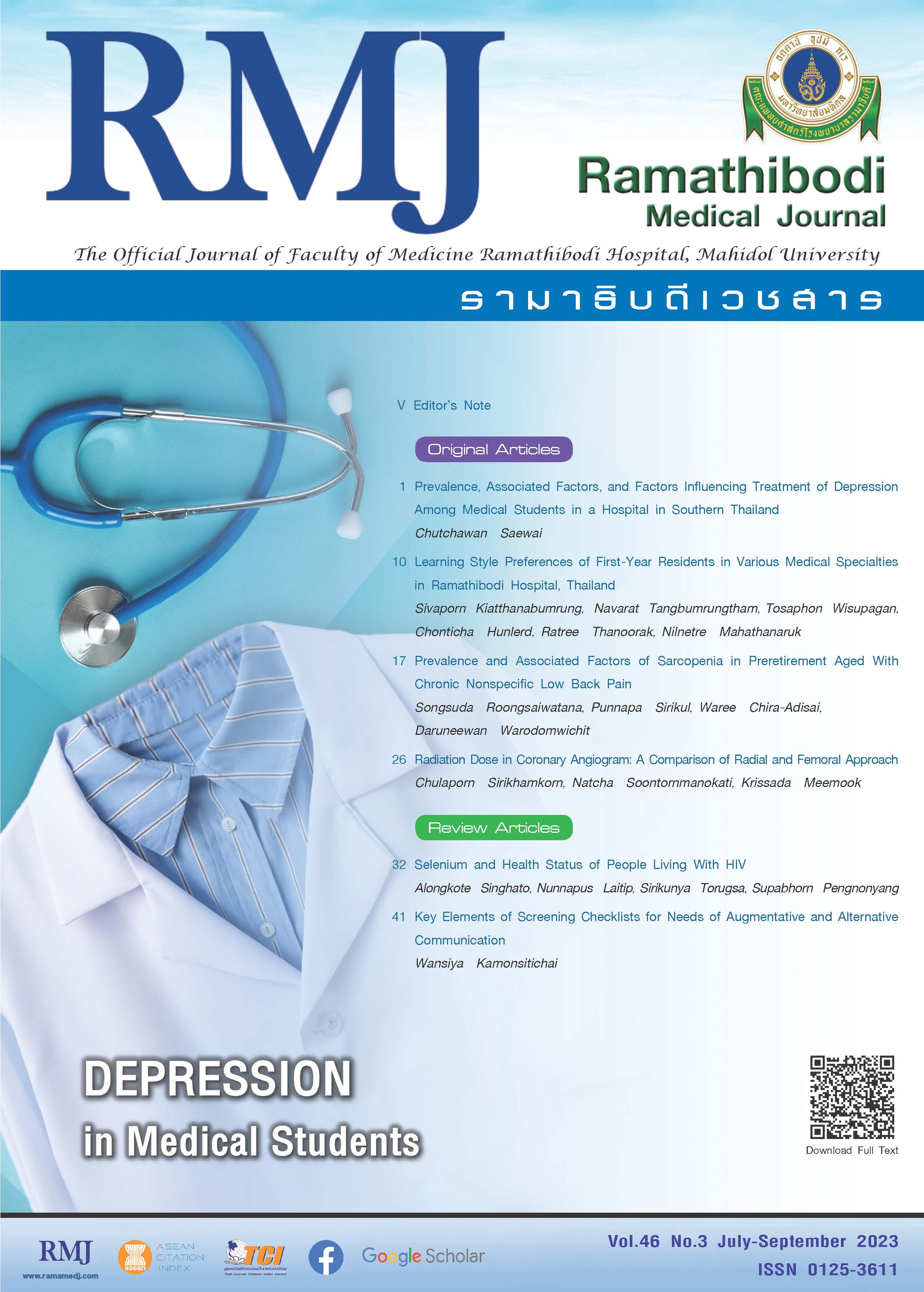Radiation Dose in Coronary Angiogram: A Comparison of Radial and Femoral Approach
DOI:
https://doi.org/10.33165/rmj.2023.46.3.262774Keywords:
Radiation, Coronary angiogram, Radial, FemoralAbstract
Background: Many clinical trials have demonstrated the benefit of trans-radial access (TRA) over trans-femoral access (TFA) in reducing mortality and bleeding events, but there is some concern about radiation exposure with radial access.
Objective: To assess the difference in radiation exposure between radial and femoral approach as measured by dose-area product (DAP) and fluoroscopy time.
Methods: This cross-sectional study was performed in patients aged 15 years and above who underwent invasive percutaneous coronary angiography at Ramathibodi Hospital between December 2019 and December 2020. Exclusion criteria included previous coronary artery bypass graft, unstable hemodynamic status during procedure, and changing the access site or using access sites other than femoral or radial arteries. Demographic data of patients was collected through medical records. DAP and fluoroscopy time of patients with radial and femoral approach were evaluated.
Results: Of 427 patients (49.4% male wtih mean age of 65.7 years), 245 (57.4%) patients underwent TFA. There was no significant difference in the median DAP between the radial and femoral approach (radial 1838 mGy.cm2 vs femoral 1690.7 mGy.cm2, P = .31). However, the fluoroscopy time was significantly higher in radial approach group (radial 4.6 min vs femoral 3.3 min, P < .001).
Conclusions: The radiation exposure was not significantly different between trans-radial and trans-femoral coronary angiography.
References
Valgimigli M, Frigoli E, Leonardi S, et al. Radial versus femoral access and bivalirudin versus unfractionated heparin in invasively managed patients with acute coronary syndrome (MATRIX): final 1-year results of a multicentre, randomised controlled trial. Lancet. 2018;392(10150):835-848. doi:10.1016/S0140-6736(18)31714-8
Jolly SS, Yusuf S, Cairns J, et al. Radial versus femoral access for coronary angiography and intervention in patients with acute coronary syndromes (RIVAL): a randomised, parallel group, multicentre trial. Lancet. 2011;377(9775):1409-1420. doi:10.1016/S0140-6736(11)60404-2
Ibanez B, James S, Agewall S, et al. 2017 ESC Guidelines for the management of acute myocardial infarction in patients presenting with ST-segment elevation: the task force for the management of acute myocardial infarction in patients presenting with ST-segment elevation of the European Society of Cardiology (ESC). Eur Heart J. 2018;39(2):119-177. doi:10.1093/eurheartj/ehx393
O’Gara PT, Kushner FG, Ascheim DD, et al. 2013 ACCF/AHA guideline for the management of ST-elevation myocardial infarction: a report of the American College of Cardiology Foundation/American Heart Association Task Force on Practice Guidelines. Circulation. 2013;127(4):e362-e425. doi:10.1161/CIR.0b013e3182742cf6
Vano E, Gonzalez L, Ten JI, Fernandez JM, Guibelalde E, Macaya C. Skin dose and dose-area product values for interventional cardiology procedures. Br J Radiol. 2001;74(877):48-55. doi:10.1259/bjr.74.877.740048
Hart D, Jones DG, Wall BF. Estimation of Effective Dose in Diagnostic Radiology From Entrance Surface Dose and Dose-Area Product Measurements. National Radiological Protection Board; 1994.
Mercuri M, Mehta S, Xie C, Valettas N, Velianou JL, Natarajan MK. Radial artery access as a predictor of increased radiation exposure during a diagnostic cardiac catheterization procedure. JACC Cardiovasc Interv. 2011;4(3):347-352. doi:10.1016/j.jcin.2010.11.011
Jolly SS, Cairns J, Niemela K, et al. Effect of radial versus femoral access on radiation dose and the importance of procedural volume: a substudy of the multicenter randomized RIVAL trial. JACC Cardiovasc Interv. 2013;6(3):258-266. doi:10.1016/j.jcin.2012.10.016
Lo TS, Ratib K, Chong AY, Bhatia G, Gunning M, Nolan J. Impact of access site selection and operator expertise on radiation exposure; a controlled prospective study. Am Heart J. 2012;164(4):455-461. doi:10.1016/j.ahj.2012.06.011
Kuipers G, Delewi R, Velders XL, et al. Radiation exposure during percutaneous coronary interventions and coronary angiograms performed by the radial compared with the femoral route. JACC Cardiovasc Interv. 2012;5(7):752-757. doi:10.1016/j.jcin.2012.03.020
Rigattieri S, Sciahbasi A, Drefahl S, et al. Transradial access and radiation exposure in diagnostic and interventional coronary procedures. J Invasive Cardiol. 2014;26(9):469-474.
Pancholy SB, Joshi P, Shah S, Rao SV, Bertrand OF, Patel TM. Effect of vascular access site choice on radiation exposure during coronary angiography: the REVERE trial (Randomized Evaluation of Vascular Entry Site and Radiation Exposure). JACC Cardiovasc Interv. 2015;8(9):1189-1196. doi:10.1016/j.jcin.2015.03.026
Ball WT, Sharieff W, Jolly SS, et al. Characterization of operator learning curve for transradial coronary interventions. Circ Cardiovasc Interv. 2011;4(4):336-341. doi:10.1161/CIRCINTERVENTIONS.110.960864
Romagnoli E, Biondi-Zoccai G, Sciahbasi A, et al. Radial versus femoral randomized investigation in ST-segment elevation acute coronary syndrome: the RIFLE-STEACS (Radial Versus Femoral Randomized Investigation in ST-Elevation Acute Coronary Syndrome) study. J Am Coll Cardiol. 2012;60(24):2481-2489. doi:10.1016/j.jacc.2012.06.017
Downloads
Published
How to Cite
Issue
Section
License
Copyright (c) 2023 Ramathibodi Medical Journal

This work is licensed under a Creative Commons Attribution-NonCommercial-NoDerivatives 4.0 International License.

















